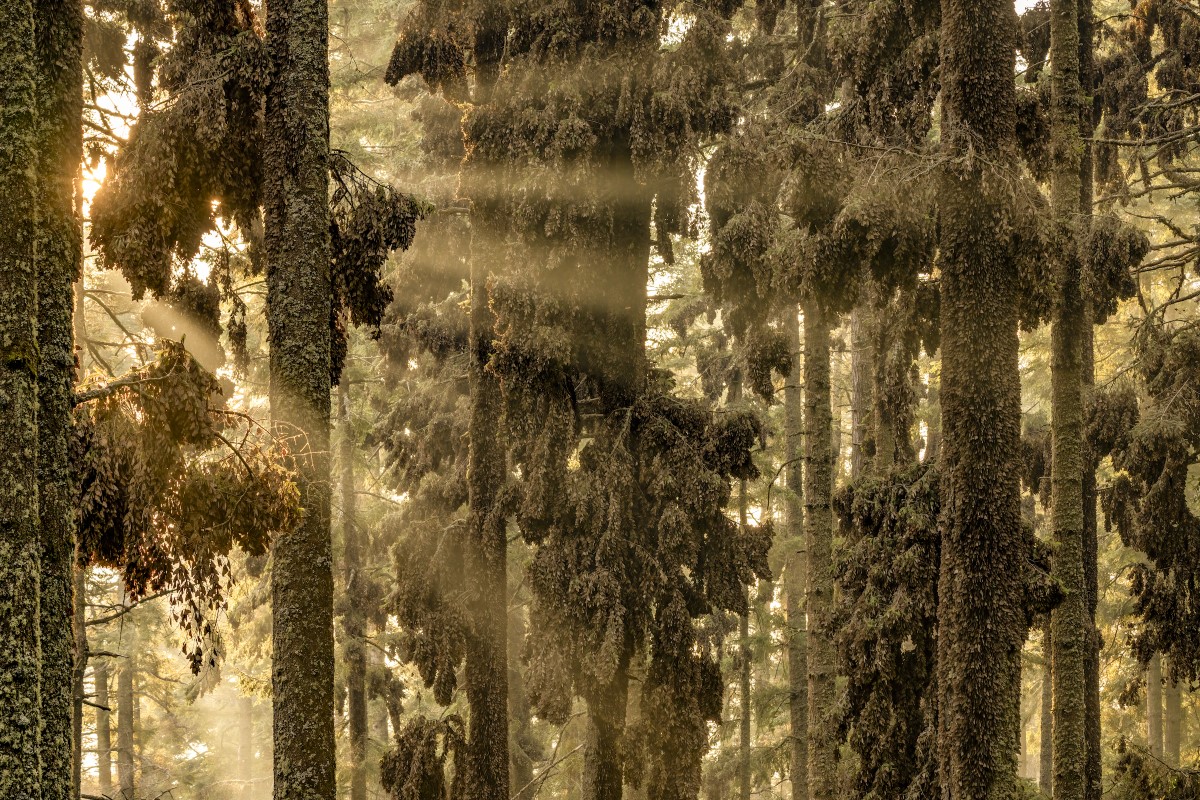
“The Forest of the Monarchs” by Jaime Rojo. Grand Prize Winner.
“Upon first glance, this scene looks little more than a sunlit patch of leafy trees. But those clumps hanging off branches and blanketing tree trunks are actually millions of monarch butterflies (Danaus plexippus), huddled for warmth in one of Mexico’s famous overwintering sites.
Photographer Jaime Rojo captured this sunset scene on Michoacan’s Monarch Butterfly Biosphere Reserve, a UNESCO World Heritage Site and annual overwintering grounds for the iconic butterflies. Though these orange-and-white beauties are perhaps the most familiar butterfly species in the world, monarchs nevertheless face existential challenges from encroaching agriculture, climate change, and deforestation of their overwintering grounds. Rojo’s image serves as both a stunning representation of the monarch’s epic migration, and a visual reminder of the close symbiosis between these butterflies and the oyamel firs they rely on to survive.”
For the 11th year, the California Academy of Sciences has announced the winners of its renowned BigPicture Photography Competition. Chaired by acclaimed wildlife photographer Suzi Eszterhas, the photo contest highlights our planet’s biodiversity, while at the same time speaking to the struggles that it faces.
National Geographic contributing photographer Jaime Rojo won the Grand Prize for a striking photo taken in Mexico’s Monarch Butterfly Biosphere Reserve. At first glance, the image simply appears to be a forest at sunset. But when it becomes clear that the clusters of “leaves” hanging from branches and blanketing the tree trunks are actually monarch butterflies, the photo takes on new meaning.
The image, taken during Rojo’s two years of research for a National Geographic cover story on the plight of the monarch butterfly, is a wonderful visual of their impressive migration. And, at the same time, it’s a reminder that we need to do all that we can to ensure that these beautiful creatures thrive in the face of encroaching agriculture, climate change, and deforestation.
Another standout winner is Maddy Rifka, whose image of a Hoopa Valley tribal member working on a controlled burn of the California forest won the Human/Nature category. The image forces us to reevaluate our thinking when it comes to wildfires, as the state’s indigenous peoples have historically used fire to promote growth and maintain biodiversity. Currently, federal officials have begun to embrace this practice, and given stewardship back to the tribes that once maintained the lands in a recognition that the practice is beneficial.
Scroll down to see more of the winner’s from this year’s competition, which give plenty of food for thought about the environment and what’s needed to protect it.
These images originally appeared on bioGraphic, an online magazine about nature and regeneration and the official media sponsor for the California Academy of Sciences’ BigPicture Natural World Photography Competition.
Here are the winners of the 2024 BigPicture Photography Competition.
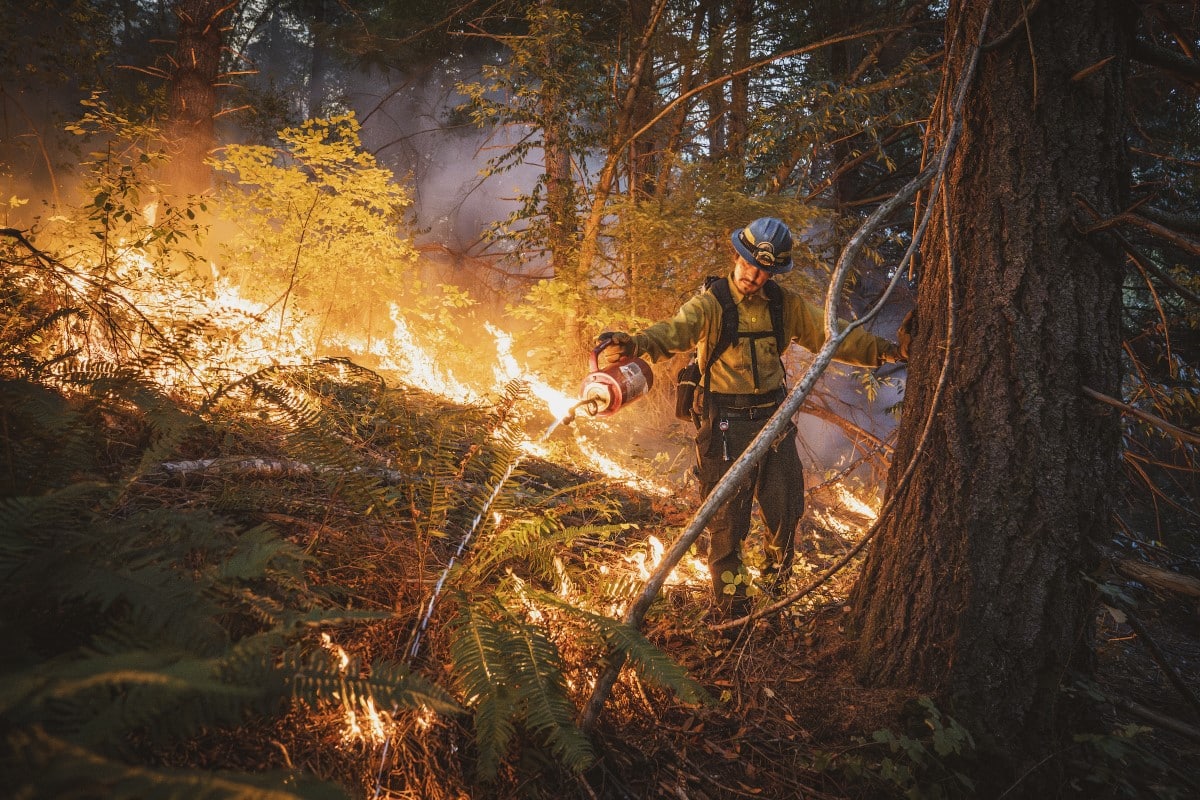
“Good Fire” by Maddy Rifka. Human/Nature Winner.
“When you hear the words ‘wildfire’ and ‘California,’ many think first of ‘devastation,’” said photographer Maddy Rifka, referring to the spate of deadly, massive wildfires that have ripped through western North America in recent years. Yet for centuries, tribal communities across the West recognized fire as a force for good. Indigenous peoples of California historically tended the land by igniting frequent, low-intensity burns, mimicking natural disturbances caused by lightning. And where fire went, life followed. By clearing fire-prone brush that might otherwise take over, these regular burns encouraged beneficial growth patterns for native plants and fruits, simultaneously maintaining biodiversity and protecting local water supplies. Unfortunately, an era of federally enforced wildfire suppression and forest mismanagement primed Western forests for the kind of severe, mass-scale burns we experience today, thus maligning fire as unequivocally ‘bad’.
Only in recent years have federal officials and Western scientists begun to embrace fire as a crucial component of forest management and a ritual interlocking land stewardship with Indigenous cultural practice. Steven Saiz, pictured, is a Hoopa Valley tribal member and one of many Native Americans fighting to reclaim their ancestral right to burn on California lands. In this particular blaze, Saiz pours a steady stream of fuel onto a patch of brush, coaxing the flames to spread through the dense undergrowth surrounding a Yurok Tribe elder’s home. Here, Saiz knows that this intentional form of “destruction” will eventually encourage new life on the Yurok Reservation, and protect lives from the deadly, out-of-control blazes that have too often torn apart mismanaged forestlands. To Saiz, this burn is as much a tool of ecological regeneration as it is a form of elder care.”
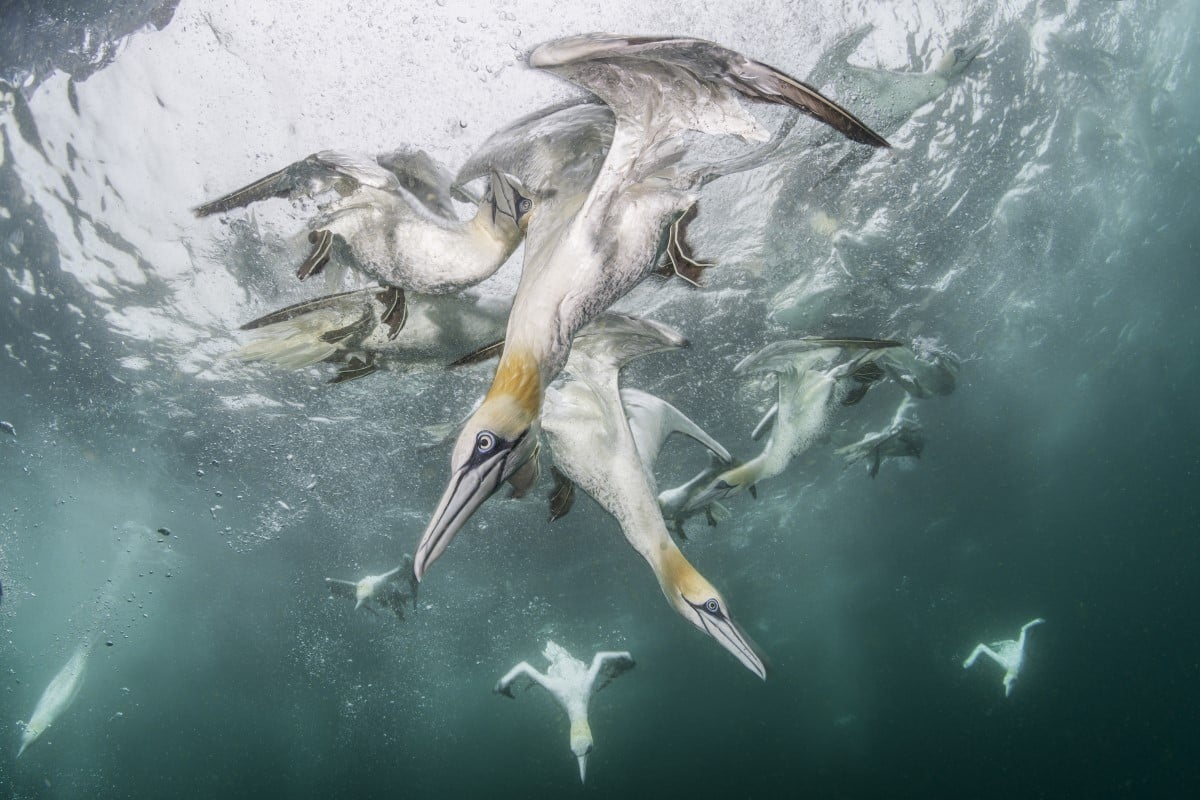
“Underwater Harmony and Chaos” by Franco Banfi. Winged Life Winner.
“The Ancient Greek word for “foolish” is móros, which is both a tongue-in-cheek epithet and the unfortunate namesake for the northern gannet (Morus bassanus). This Atlantic-dwelling gannet subspecies lives up to its name in more ways than one: Taxonomists apparently chose the genus name because of the gannet’s fearlessness when approached on their nesting grounds. Yet these birds are perhaps more famous for their dramatic hunting behavior, which sees flocks of gannets diving like vertical torpedoes from dozens of feet above the water’s surface. With their bills outstretched and wings folded tightly against their bodies, northern gannets can reach speeds up to 60 miles per hour and depths up to 70 feet as they jab into ocean waters to poach their prey. Following a cluster of fishing vessels off the coast of Scotland’s Shetland Islands, photographer Franco Banfi tracked an active colony of northern gannets and their feeding route, diving into the dark water to visually capture the chaos, beauty, and unexpected harmony of the gannet’s daily fight for food and survival.”
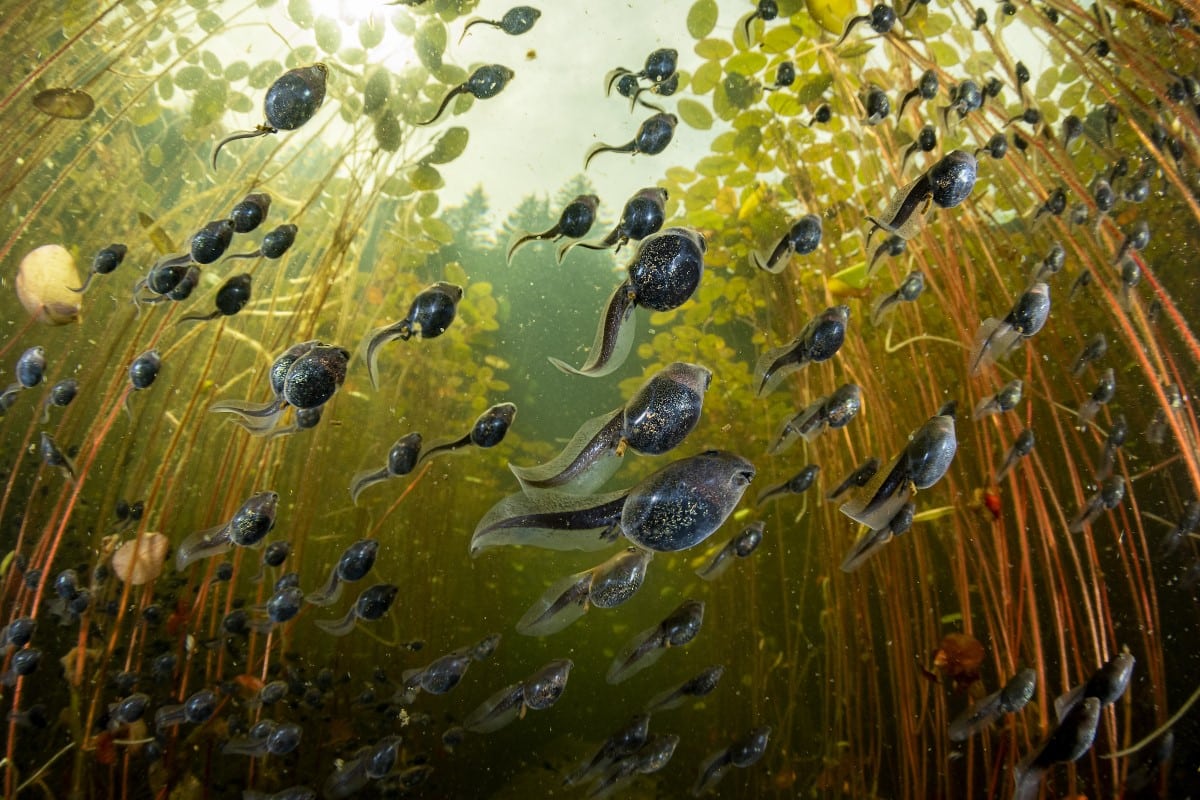
“Tadpole Migration” by Shane Gross. Aquatic Life Winner.
“Every summer day in the lakes of Vancouver Island, hundreds of paperclip-sized western toad tadpoles (Anaxyrus boreas) wriggle their way from the relatively safe depths of the water into sunlit shallows, where algae thrives and dinner awaits. Veteran underwater photographer Shane Gross had heard of the tadpoles’ great migration and spent a summer morning exploring a lake in the northern part of the island, only to learn from a local that the tadpoles tended to surface en masse in the late afternoon. Returning to the lake some hours later, camera in tow, Gross was amazed by the numbers of tadpoles he witnessed dancing in the water, their quick movements revealing little flecks of gold on their otherwise opaque black skin. Using a tilted fish-eye lens, Gross was able to capture both the tadpoles’ rapturous journey to find sustenance and glimpses of the lake’s thicket of lily pads and towering forest-covered mountains. These tadpoles seem to have found strength in numbers, swarming past attacks from water bugs and leeches to continue nibbling on food—and any other appealing organisms that passed by.”

“In Celebration” by Geo Cloete. Landscape, Waterscapes, and Flora Winner.
“Wading in the tidepools off of South Africa’s Cape Peninsula, photographer Geo Cloete’s vision and creative use of a fisheye lens captured the stunning symbiosis between the ocean’s crashing waves and sea anemones: Only when there is a chance of feeding do these colorful cnidarians bloom, extending their nimble tentacles outward to ensnare plankton, crabs, and tiny fish. The vehicle for their prey? The breaking waves themselves, which sweep over tidepools and their inhabitants during high tide, delivering nutrients and other microscopic organisms to the pool’s intricate food web.”
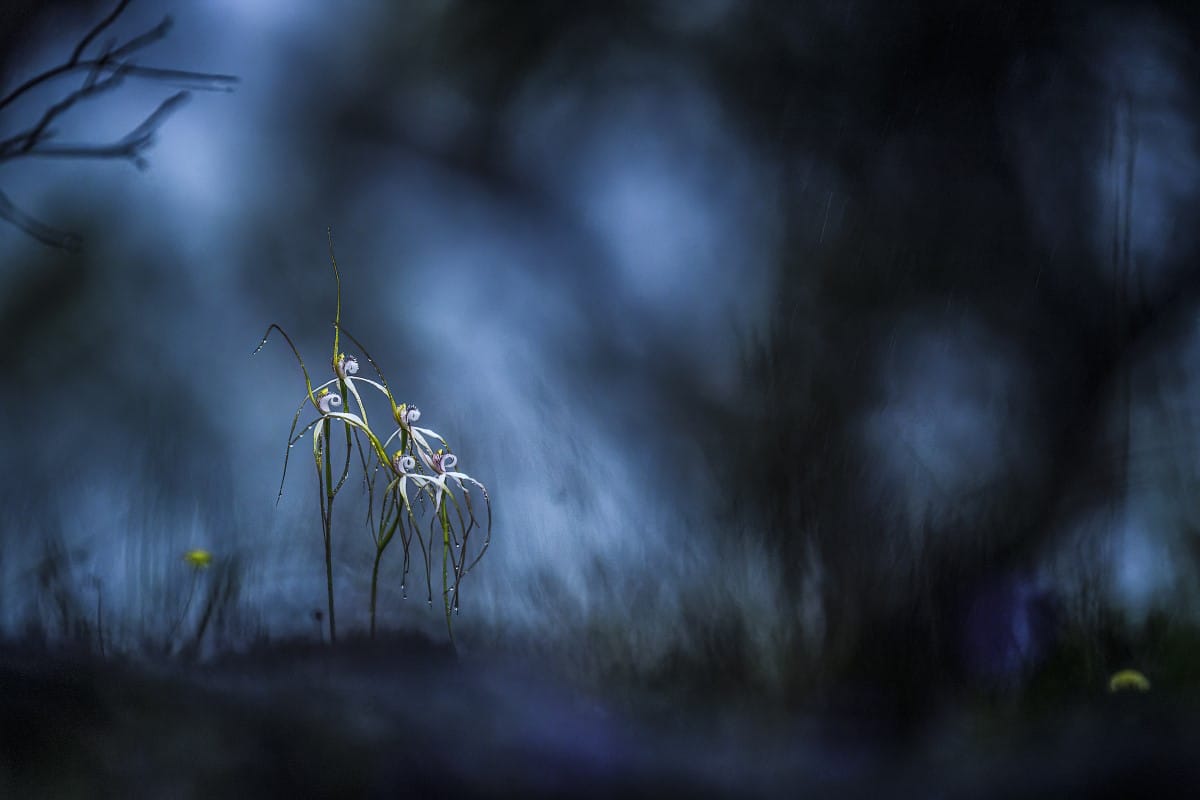
“March of the Spider Orchids” by Georgina Steytler. Landscapes, Waterscapes, & Flora Finalist.
“Against the moody, rain-soaked backdrop of Western Australia’s southern coast, flowers from a lone white spider orchid (likely of the Caladenia longicauda species complex) emerge from the brush and unfurl their spindly arms. Photographer Georgina Steytler used a combination of visual techniques to capture the eerie essence of these plants, whose flowering bodies and scents resemble those of their would-be pollinators. Several Caladenia orchid species are what scientists call “sexually deceptive,” producing so-called pseudopheromones that mimic the scent of female wasps. Paired with the orchid’s unique color and shape, these adaptations lure male wasps from afar and inspire them to try to copulate with the flower, covering the wasps with pollen in the process.”
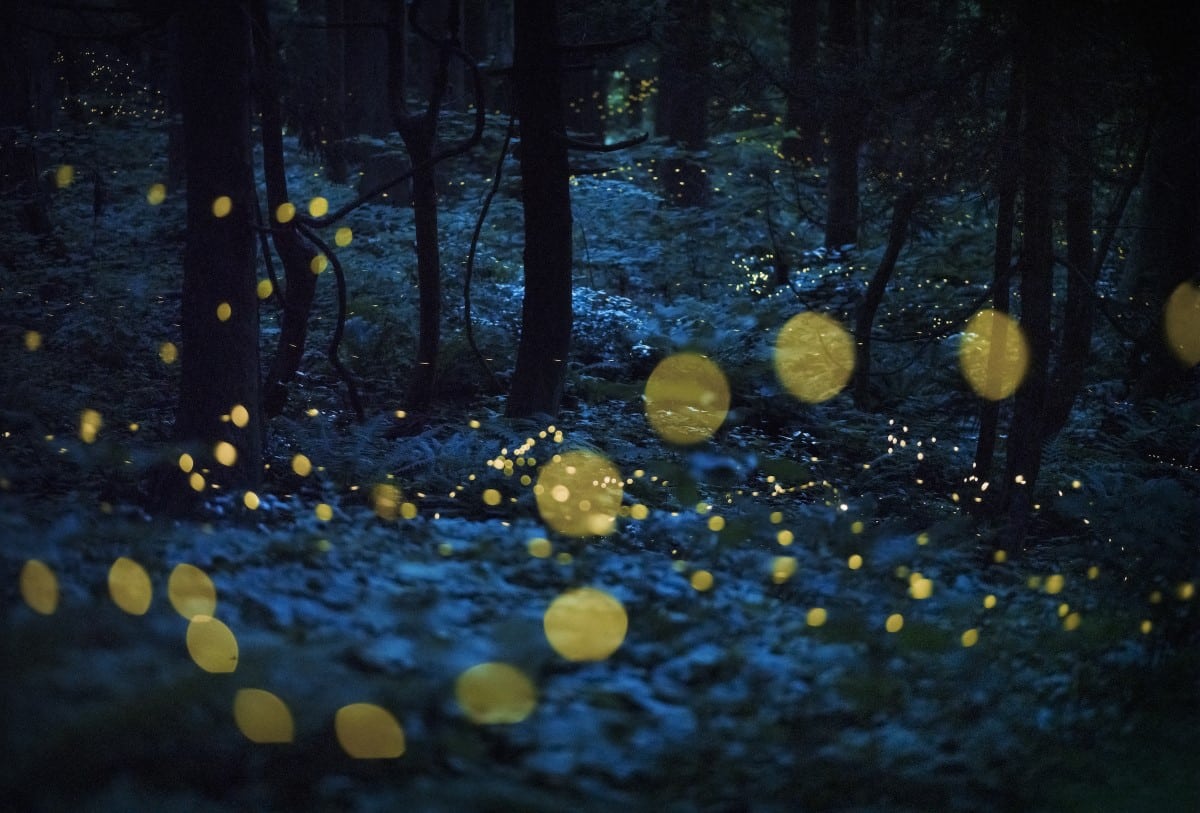
“Stardust Forest” by Kazuaki Koseki. Art of Nature Winner.
“Would you believe your eyes if you saw 10 million fireflies before you, dancing in the skies and lighting up the forest? Photographer Kazuaki Koseki would, having spent the past seven years studying the ecology and photographing the beautiful parabolic trajectories of these seemingly magical insects in the forests of the Yamagata Prefecture. Fireflies hold particular cultural importance in Japan, where their emergence marks the changing of the seasons and is thought to be a manifestation of the souls of soldiers who died in war. The floating light trails captured in this photo were mostly created by male fireflies, who hover and emit frequent bursts of light when trying to court mates. With smaller back wings that render them flightless, female fireflies of this particular species wait patiently on the forest floor or on trees, signaling to males every few seconds with similar flashes of light. Although Koseki’s use of long exposure helped illustrate the wandering luminescence of hundreds of fireflies, he ultimately viewed these insects as his creative collaborators: “The himebotaru is an artist, who paints light in the forest,” Koseki said.”
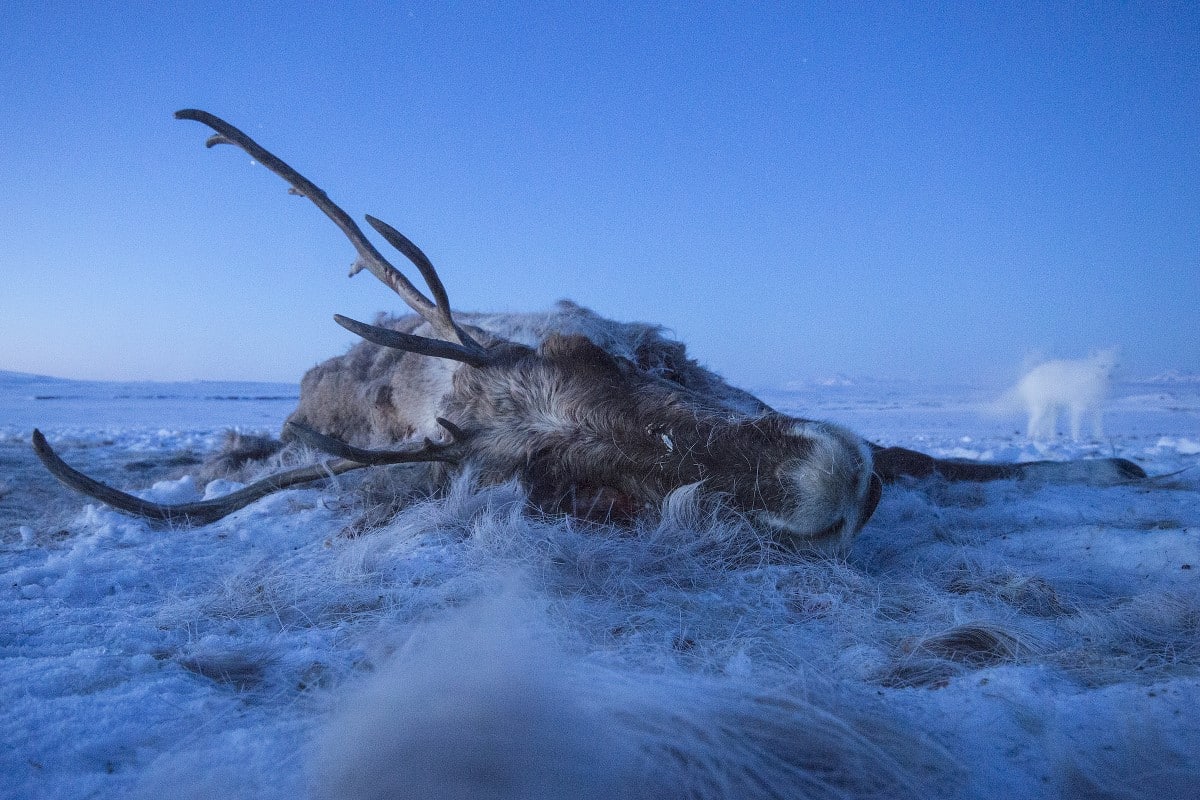
“Northern Ghosts” by Peter Mather. Photo Story Winner.
“Despite being one of the coldest and most barren places on Earth, the North American Arctic is surprisingly biodiverse. The region is famous for cold-adapted and iconic wildlife like caribou, bears, and wolves, yet native Northerners know these animals to be extremely elusive, leaving behind few traces of life beyond tracks in the snow and howls in the night. To photographer Peter Mather, finding the Arctic’s transient wildlife feels like trying to pin down a ghost or apparition, which ultimately became the theme uniting Mather’s artfully rendered photo story. By placing motion-activated camera traps in the field and often leaving them over the span of months or years, Mather captured five rare visuals of wildlife in the ice-covered expanses of the Arctic, including this caribou (Rangifer tarandus granti) carcass pictured on Alaska’s North Slope. He then used both flash photography and a long exposure to illustrate the fleeting presence of an Arctic fox that seemed to be as curious about the carcass as he was.”
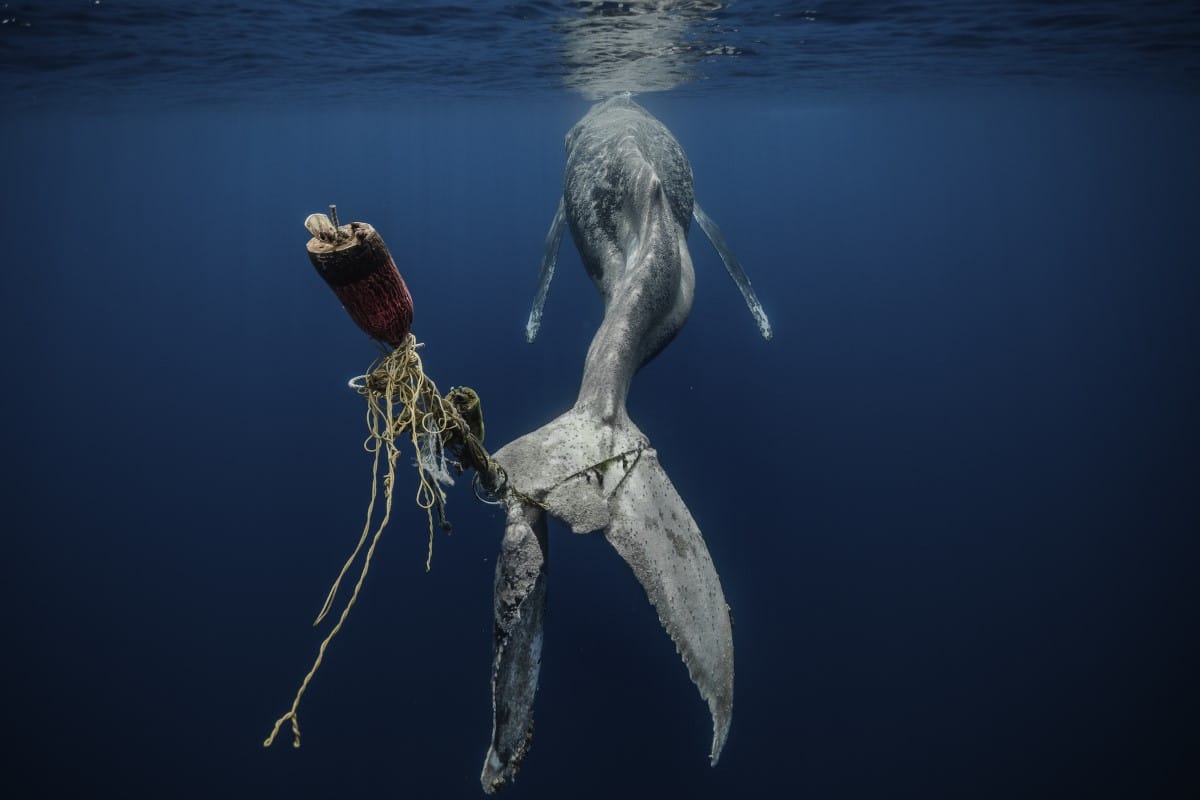
“Hopeless” by Alvaro Herrero. Human/Nature Finalist.
“This haunting image of an entangled humpback whale (Megaptera novaeangliae) captures the grim reality these magnificent marine mammals face in oceans around the world. Decades of aggressive whale hunting, vessel strikes, disease, and entanglement in fishing gear have collectively killed thousands of humpback whales and kept many cetacean populations worldwide on the brink of extinction. Photographer Alvaro Herrero says he captured the fatal entanglement of this juvenile humpback whale in order to paint an unflinching image of the life-threatening conditions whales face along their migrations—and also to illustrate the slow, painful death of our planet at the hands of human selfishness and inactivity.”

“A Moment in the Sun” by Kathleen Borshanian. Terrestrial Wildlife Finalist.
“Perched on the cliffs of the Pribilof Islands, this adorable Arctic blue fox (Vulpes lagopus pribilofensis) appears completely unbothered and tranquil as it basks in the sunlight—a rare occurrence for an archipelago often shrouded in a thick blanket of fog. Arctic blue foxes are endemic to these remote islands, which emerge from the Bering Sea some 750 miles west of Anchorage, Alaska. Despite their seclusion and the near-complete lack of trees, the Pribilof Islands are surprisingly biodiverse, dubbed the “Galapagos of the North” by some biologists. The archipelago is the product of repeated volcanic eruptions that began hundreds of thousands of years ago, and today is home to northern fur seal colonies, millions of seabird nests, and very few humans. Yet mammals like the Arctic blue fox have adapted over generations to the unique, treeless environment: Below the pictured fox appears to be the entrance of a sprawling maze of tunnels that form an interconnected, underground nest for these secretive mammals. Photographer Kathleen Borshanian says the dens are practically ubiquitous on the Pribilof Islands, winding their way within a few feet of the island’s sheer 1,000-foot-high basaltic cliffs, and they serve as a crucial refuge from predators and a safe haven for rearing the next generation of fox pups.”
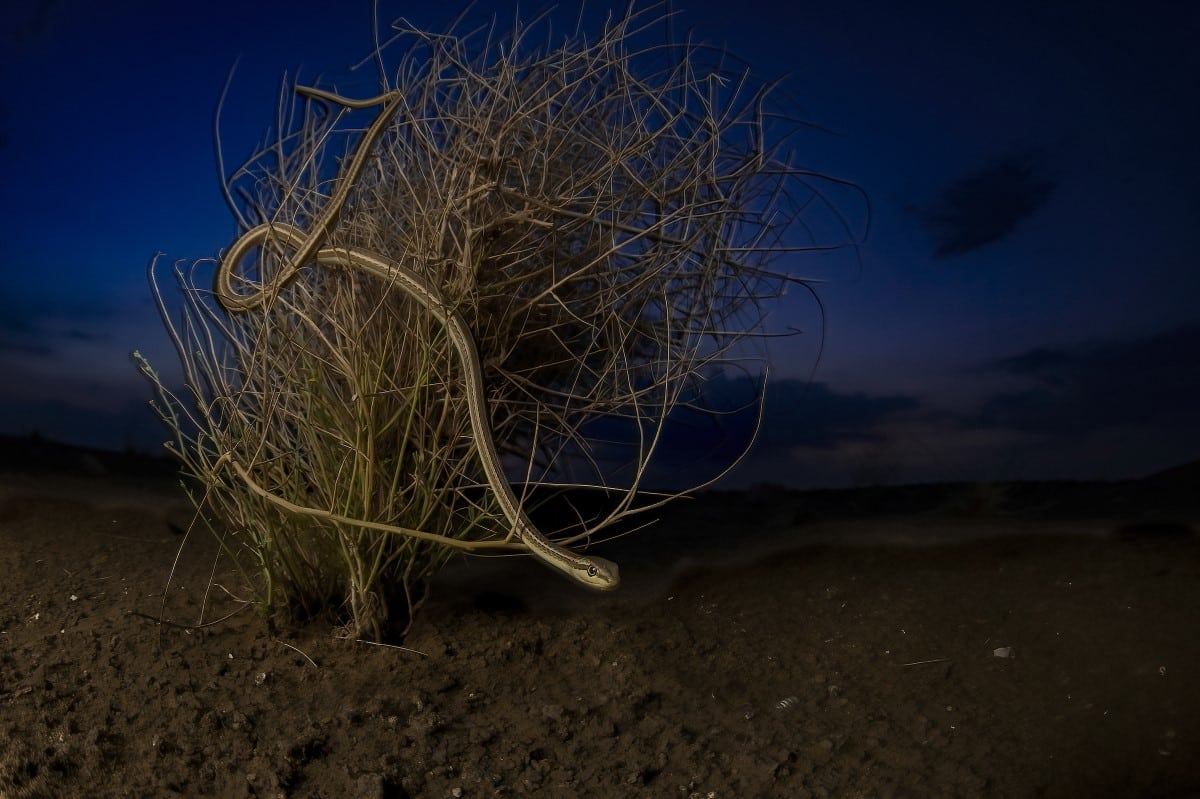
“Beauty of the Desert” by Hema Palan. Terrestrial Wildlife Winner.
“Even though the Schokari sand racer (Psammophis schokari) is known for its whip-fast speed and agility, photographer Hema Palan managed to capture a tranquil nighttime shot of a lone sand racer moving through the branches of a shrub in India’s Thar Desert. As a diurnal ambush predator, this reptile was likely settling in for a night of rest before emerging in the daylight to hunt lizards, rodents, and other prey. Their pursuits can reach speeds of up to 16 kilometers per hour, earning the sand racer its title as one of the Middle East’s fastest snakes.”
